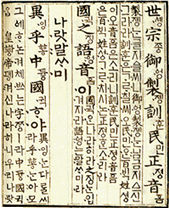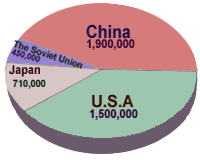 <Hoon-Min-Jeong-Eum> |
Koreans call their alphabet Hangul. Like English, the letters
of the Hangul alphabet represent individual sounds or phonemes. Hangul was invented by King Sejong of the Choson Dynasty, and introduced to the public in 1443 in Hun-Min-Jeong-Eum. King Sejong believed that Koreans needed an easy-to-learn system for writing their own language. Before King Sejong deigned the Hangul, Koreans had either written in the Chinese language or had written Korean using Chinese characters to represent the Korean sounds in a complex system, Idu. The alphabet originally contained 28 letters composed of 11 vowels and 17 consonants. |
| Currently Hangul is spoken by 45 million people in South Korea, in addition to 23 million in North Korea and several million Koreans living in other countries like China(1.9 million), the United States(1.5 million), Japan(710,000), and the former Soviet Union(450,000). Hangul is being taught in about 50 American and Canadian universities, with more being added each year. It is also taught at more than 20 universities in Europe, East Asia, and Australia. As Korea plays a greater role in world economics and politics, it is becoming more and more important for the international community to understand the Korean people and their language. |  |

